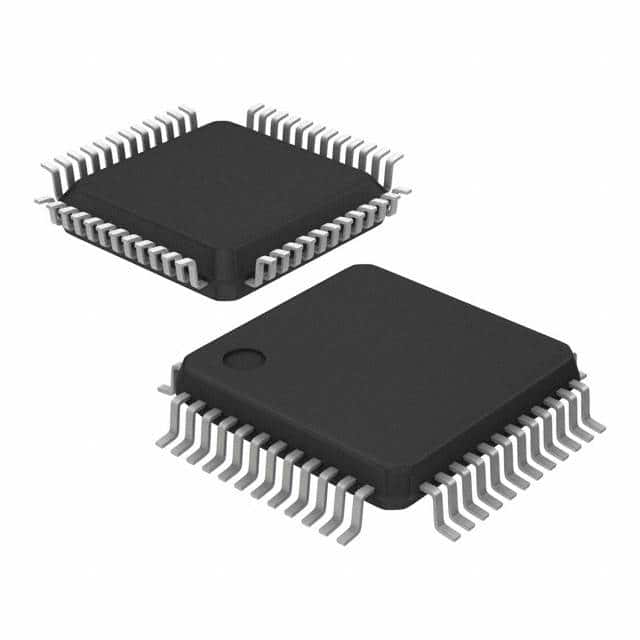Xem thông số kỹ thuật để biết chi tiết sản phẩm.

MSP430F2471TPM
Product Overview
The MSP430F2471TPM belongs to the MSP430 family of ultra-low-power microcontrollers produced by Texas Instruments. This microcontroller is designed for a wide range of applications, offering low power consumption and high performance.
Basic Information
- Category: Microcontroller
- Use: Embedded systems, IoT devices, battery-powered applications
- Characteristics: Ultra-low power consumption, high performance, integrated peripherals
- Package: 64-pin LQFP
- Essence: Efficient and reliable microcontroller for low-power applications
- Packaging/Quantity: Tape and reel, 2500 units per reel
Specifications
- CPU: 16-bit RISC architecture
- Clock Speed: Up to 16 MHz
- Memory: 32 KB Flash, 2 KB RAM
- Peripherals: ADC, DAC, UART, SPI, I2C, Timer modules
- Operating Voltage: 1.8V to 3.6V
- Low Power Modes: Multiple low-power modes for energy efficiency
Detailed Pin Configuration
The MSP430F2471TPM features a 64-pin LQFP package with detailed pin configuration for interfacing with external components and peripherals. The pinout includes GPIO pins, communication interfaces, power supply pins, and other essential connections.
Functional Features
- Ultra-Low Power Consumption: Ideal for battery-powered applications and energy-efficient designs.
- Integrated Peripherals: Built-in ADC, DAC, and communication interfaces reduce the need for external components.
- High Performance: 16-bit RISC architecture provides efficient processing capabilities.
- Flexible Clocking Options: Supports various clock sources and low-power modes for optimized performance.
Advantages and Disadvantages
Advantages
- Low power consumption extends battery life in portable devices.
- Integrated peripherals reduce external component count and PCB footprint.
- High-performance RISC architecture enables efficient data processing.
Disadvantages
- Limited memory capacity compared to some competing microcontrollers.
- Higher cost compared to entry-level microcontrollers with similar features.
Working Principles
The MSP430F2471TPM operates on ultra-low power principles, utilizing its advanced architecture and low-power modes to minimize energy consumption. It efficiently processes data and communicates with external devices while consuming minimal power, making it suitable for battery-powered and energy-conscious applications.
Detailed Application Field Plans
The MSP430F2471TPM is well-suited for a variety of applications, including: - Portable medical devices - Wearable electronics - Sensor nodes for IoT networks - Energy harvesting systems - Industrial control systems
Detailed and Complete Alternative Models
- MSP430F2491TPM: Similar features with increased memory capacity
- MSP430FR2355TPM: Ultra-low-power FRAM-based microcontroller for energy-critical applications
- MSP430G2553IPW28R: Entry-level microcontroller with basic features for cost-sensitive designs
In conclusion, the MSP430F2471TPM offers a balance of low power consumption, high performance, and integrated peripherals, making it an ideal choice for a wide range of embedded applications.
Word Count: 443
Liệt kê 10 câu hỏi và câu trả lời thường gặp liên quan đến ứng dụng MSP430F2471TPM trong giải pháp kỹ thuật
What is the MSP430F2471TPM microcontroller used for?
- The MSP430F2471TPM microcontroller is commonly used in technical solutions for low-power and battery-operated applications, such as portable medical devices, sensor nodes, and industrial control systems.
What are the key features of the MSP430F2471TPM?
- The MSP430F2471TPM features a 16-bit RISC CPU, up to 32KB flash memory, 1KB RAM, multiple communication interfaces, analog-to-digital converters, and low-power modes for energy-efficient operation.
How can I program the MSP430F2471TPM microcontroller?
- The MSP430F2471TPM can be programmed using various integrated development environments (IDEs) such as Code Composer Studio or Energia, which support C/C++ programming languages.
What are the typical power requirements for the MSP430F2471TPM?
- The MSP430F2471TPM operates at ultra-low power, with active mode currents as low as 220 µA/MHz and standby mode currents as low as 0.7 µA, making it suitable for battery-powered applications.
Can the MSP430F2471TPM interface with external sensors?
- Yes, the MSP430F2471TPM supports multiple communication interfaces including SPI, I2C, and UART, allowing it to easily interface with a wide range of external sensors and peripherals.
What are the available development tools for the MSP430F2471TPM?
- Texas Instruments provides a comprehensive set of development tools including evaluation boards, software libraries, and documentation to aid in the design and development of applications using the MSP430F2471TPM.
Does the MSP430F2471TPM have built-in security features?
- Yes, the MSP430F2471TPM includes hardware features such as a memory protection unit and a random number generator to enhance system security and protect sensitive data.
What are the temperature operating ranges for the MSP430F2471TPM?
- The MSP430F2471TPM is designed to operate over a wide temperature range, typically from -40°C to 85°C, making it suitable for use in harsh environmental conditions.
Can the MSP430F2471TPM be used in real-time control applications?
- Yes, the MSP430F2471TPM's high-resolution timers, PWM outputs, and analog-to-digital converters make it well-suited for real-time control applications such as motor control and power management.
Are there any known limitations or issues when using the MSP430F2471TPM?
- While the MSP430F2471TPM is a versatile microcontroller, designers should be aware of its specific limitations such as maximum clock speed, available I/O pins, and memory constraints when planning their applications.

